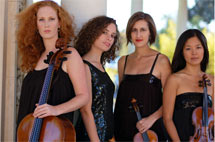

Thursday - April 15, 2010
SLAC Today is
available online at:
http://today.slac.stanford.edu
In this issue:
The New Project Safety Review Process
Einstein's Theory Fights Off Challengers
Noontime Concert by the Cecilia String Quartet Today
 |
 |
|
Thursday - April 15, 2010 |
The New Project Safety Review ProcessThis gas cabinet serving the Linac Coherent Light Source AMO instrument was among the first projects installed as a test of the new process.
A little over a year ago, Chief Safety Officer Craig Ferguson raised one of the first major issues for discussion in the new Environment, Safety & Health Subcouncil: pursuing an effective and streamlined project review process at SLAC. The motivation was to provide consistent, value-added reviews of projects, regardless of type (experimental, civil construction, etc.) A new process was implemented on a trial basis in March, with the guiding principles of strengthening line management's responsibility for project safety, appointing safety officers and subject matter experts for various hazard types, and maximizing its integration with the work planning and control program. It also clarifies the role of the principal investigator/project manager, Building Inspection Office, safety officers and coordinators, subject matter experts, as well as the safety committees, the Safety Overview Committee—or SOC—and line managers themselves. The new review process is the product of many months of often tumultuous and colorful debate between stakeholders, but this dialog enhanced the final process recommended by the ES&H Subcouncil. The Subcouncil formed sub-committees to develop review processes for "conventional projects" and "experimental (non-conventional) projects" with the underlying principle that line managers are responsible for the safety of their projects, consistent with SLAC's Integrated Safety and Environmental Management System, and that the tools should be available to help them fulfill this responsibility. Read more... Einstein's Theory Fights Off ChallengersComposite image of the galaxy cluster Abell 3376. Via different methods, two separate teams have tested gravity and General Relativity using Chandra observations of galaxy clusters. (Photo:
X-ray: NASA/CXC/SAO/A. Vikhlinin; ROSAT Optical: DSS Radio: NSF/NRAO/VLA/IUCAA/J.Bagchi.)
Two new and independent studies have put Einstein's General Theory of Relativity to the test like never before. These results, made using NASA's Chandra X-ray Observatory, show Einstein's theory is still the best game in town. Each team of scientists took advantage of extensive Chandra observations of galaxy clusters, the largest objects in the Universe bound together by gravity. One result undercuts a rival gravity model to General Relativity, while the other shows that Einstein's theory works over a vast range of times and distances across the cosmos. The first finding bolsters General Relativity by directly testing it across cosmological distances and times. Up until now, General Relativity had been verified only using experiments from laboratory to Solar System scales, leaving the door open to the possibility that General Relativity breaks down on much larger scales. To probe this question, a group at the joint SLAC-Stanford Kavli Institute for Particle Astrophysics and Cosmology compared Chandra observations of how rapidly galaxy clusters have grown over time to the predictions of General Relativity. The result is nearly complete agreement between observation and theory. "Einstein's theory succeeds again, this time in calculating how many massive clusters have formed under gravity's pull over the last five billion years," said KIPAC researcher David Rapetti, who led the new study. "Excitingly and reassuringly, our results are the most robust consistency test of General Relativity yet carried out on cosmological scales." Read more...  (Image courtesy the Cecilia String Quartet.)
Noontime Concert by the Cecilia String Quartet TodayThe Cecilia String Quartet will present a noon-time concert today in the Kavli Auditorium. This is an exciting group that has won prestigious awards. They are working with the St. Lawrence String Quartet of Stanford as part of their Emerging String Quartet program. They will play three works, Hugo Wolf, "Italian Serenade"; Kelly-Marie Murphy, "Another Little Piece of My Heart"; and Robert Schumann, String Quartet No.3 in A, Op. 41 No.3. Please join us! |
Events
Access (see all)
Announcements
|
|
| | ||
|
|
||
 <%
Response.AddHeader "Last-modified", getArticleDate()
'Response.AddHeader "Last-modified","Mon, 01 Sep 1997 01:03:33 GMT"
'Monday, December 06, 2010
%>
<%
Response.AddHeader "Last-modified", getArticleDate()
'Response.AddHeader "Last-modified","Mon, 01 Sep 1997 01:03:33 GMT"
'Monday, December 06, 2010
%>View online at http://today.slac.stanford.edu/. |
||